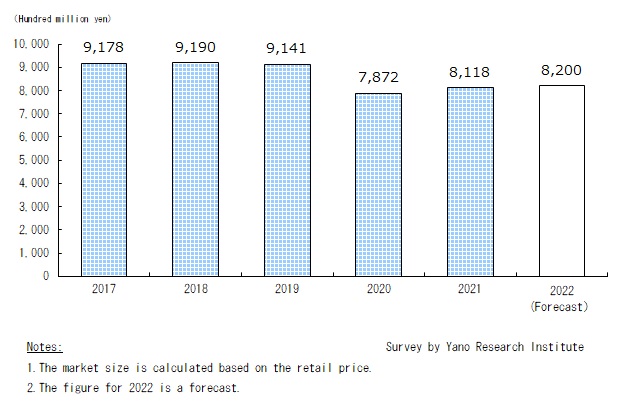No.3244
Babies' and Children's Clothing Market in Japan: Key Research Findings 2023
Babies' and Children's Clothing Market for 2022 Forecasted to Attain 820,000 Million Yen, 101.0% YOY
Yano Research Institute (the President, Takashi Mizukoshi) has conducted a survey on the domestic babies' and children's clothing market, and has found out the market size, the trends by product, and the trends by sales channel.

Market Overview
Size of the babies' and children's clothing market is estimated at 811,800 million yen in 2021, which is 103.1% of the previous year (based on the retail price). While the market has experienced moderate ups and downs in the last few years, the market plunged in 2020 due to the influence of COVID-19. Although reactionary increase from the previous year was observed for 2021, the market has not recovered to the pre-pandemic (2019) level.
Despite the record-low birth rates, the market size sustained against the background of a rise in the total amount of spending per child, coupled with the steady sales at babies’ and children’s goods retail chain stores and affordable clothing stores.
Noteworthy Topics
Companies' Attempts to Cope with Price Rise
Price of various products was raised in 2022 due to the influence of social conditions, the weak yen, and soaring prices. As this trend continues in 2023, it is suffocating many households significantly. While food prices continue to hike, soaring living expenses such as utility bills and gas prices are also massively influencing consumers' willingness to buy and opportunity to purchase clothing. Meanwhile, companies in the market of babies’ and children’s clothing are trying to manage the soaring prices by reviewing their business operation and product prices. In some cases, companies adjust inventory of regular products, reschedule product release, and raise product prices on the basis of additional rise in material prices. Others try to minimize the impact of material price rise by reinforcing production and marketing of private brands and cutting down costs further. while some companies incorporate various sales strategies, such as marking down per product and offering discounts for purchase of multiple pieces, etc., others devise ways to avoid reducing product value.
Future Outlook
Size of the domestic babies' and children's clothing retail market in 2022 is projected to grow marginally to 820,000 million yen, 101.0% of the preceding year.
Settle down of COVID-19 crisis may drive the market recovery, yet the market cannot anticipate significant expansion from the preceding year due to the serious impact of social conditions, soaring fuel prices, price hikes, etc., on consumer’s living expenses. In addition, given the continuing trend of declining birthrate in Japan, recovery to pre-pandemic levels is not foreseeable. The market is forecasted to stay at almost the same level as in the preceding year.
Research Outline
2.Research Object: Retailers, wholesalers, manufacturers and other related companies in babies' and children's clothing market
3.Research Methogology: Face-to-face interviews by the expert researchers, mailed questionnaires, and literature research
What is the Babies' and Children's Clothing Market?
The babies' and children's clothing market in this research refers to the clothing designed and produced for babies and children, with the sizes classified as “Baby (age 0-1, size 50-80cm)”, “Toddler/Kids (age 2-6, kinder, size 80-120)”, and “School Junior (age 7-14, child, size120 -160)”. The size classification is a most adopted guideline, although it may differ at each company. Clothing refers to garments only, i.e., other fashion merchandises like accessories are not included.
<Products and Services in the Market>
Babies' and children's clothing
Published Report
Contact Us
The copyright and all other rights pertaining to this report belong to Yano Research Institute.
Please contact our PR team when quoting the report contents for the purpose other than media coverage.
Depending on the purpose of using our report, we may ask you to present your sentences for confirmation beforehand.